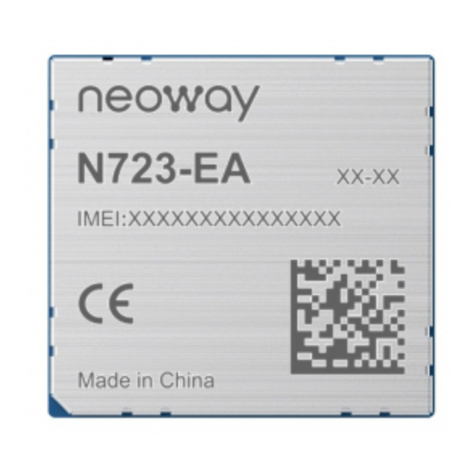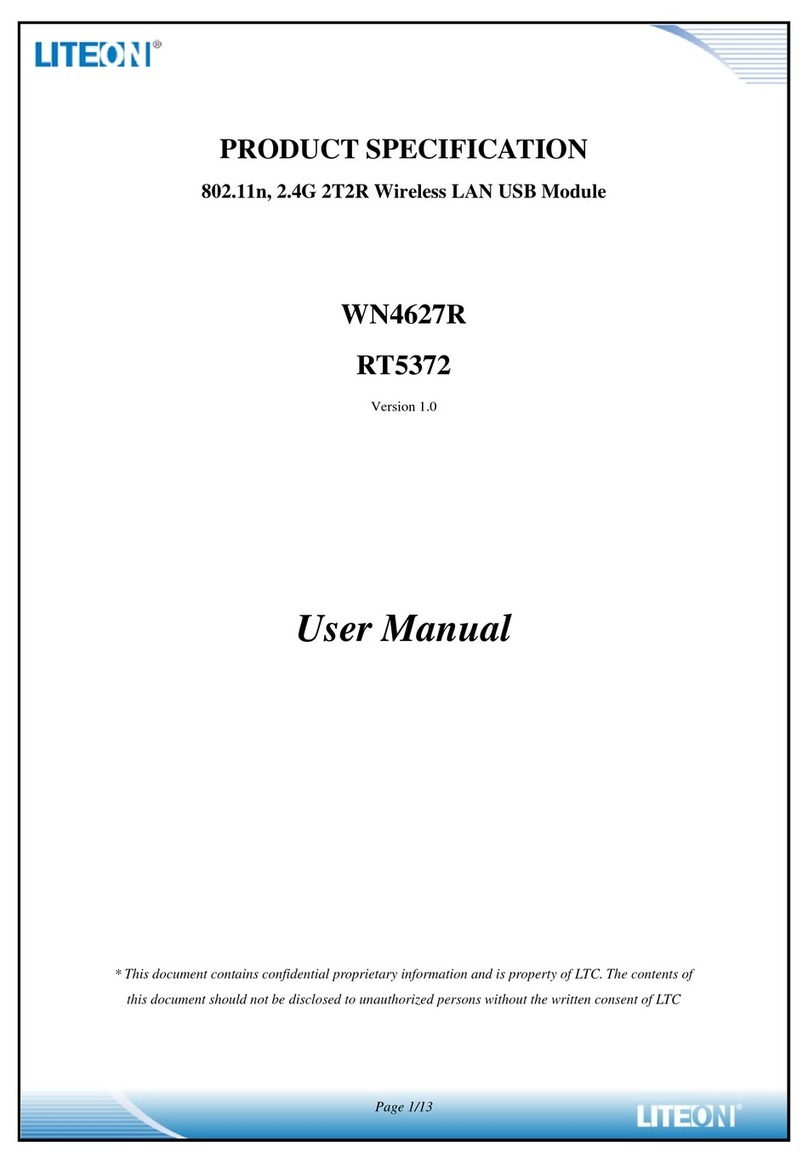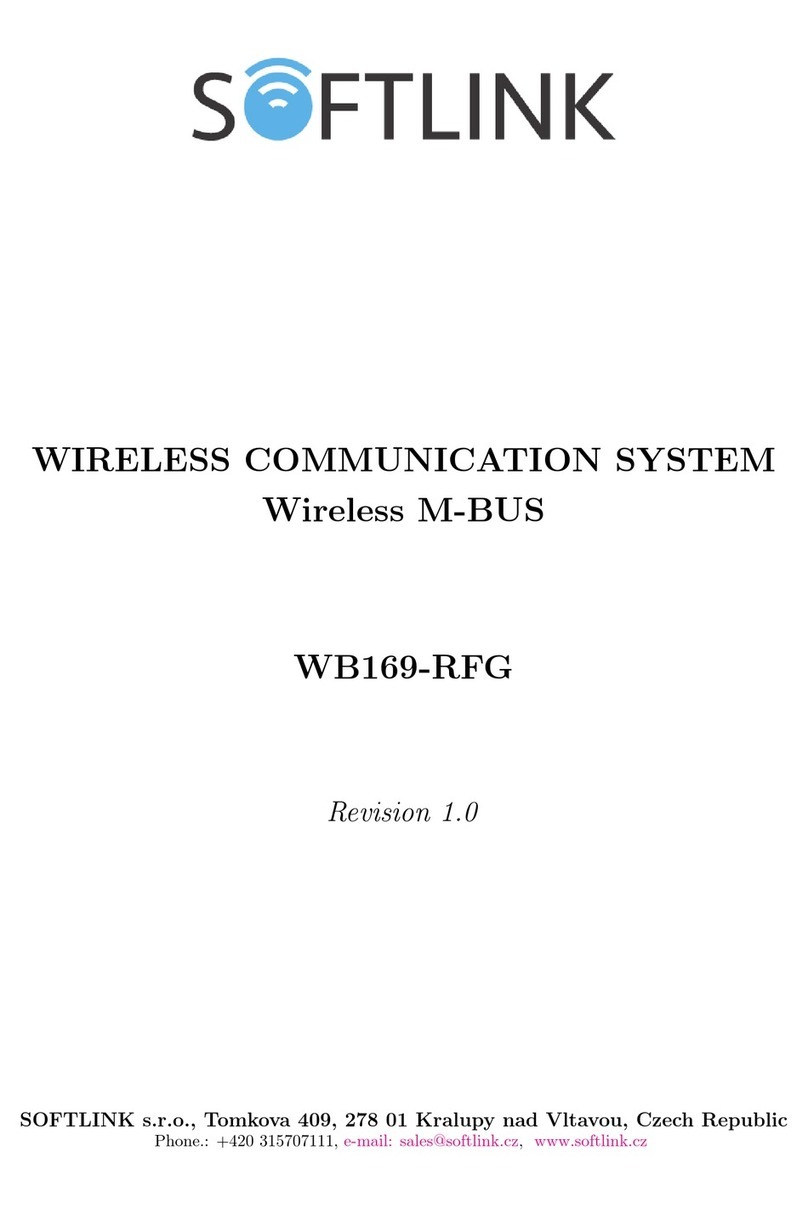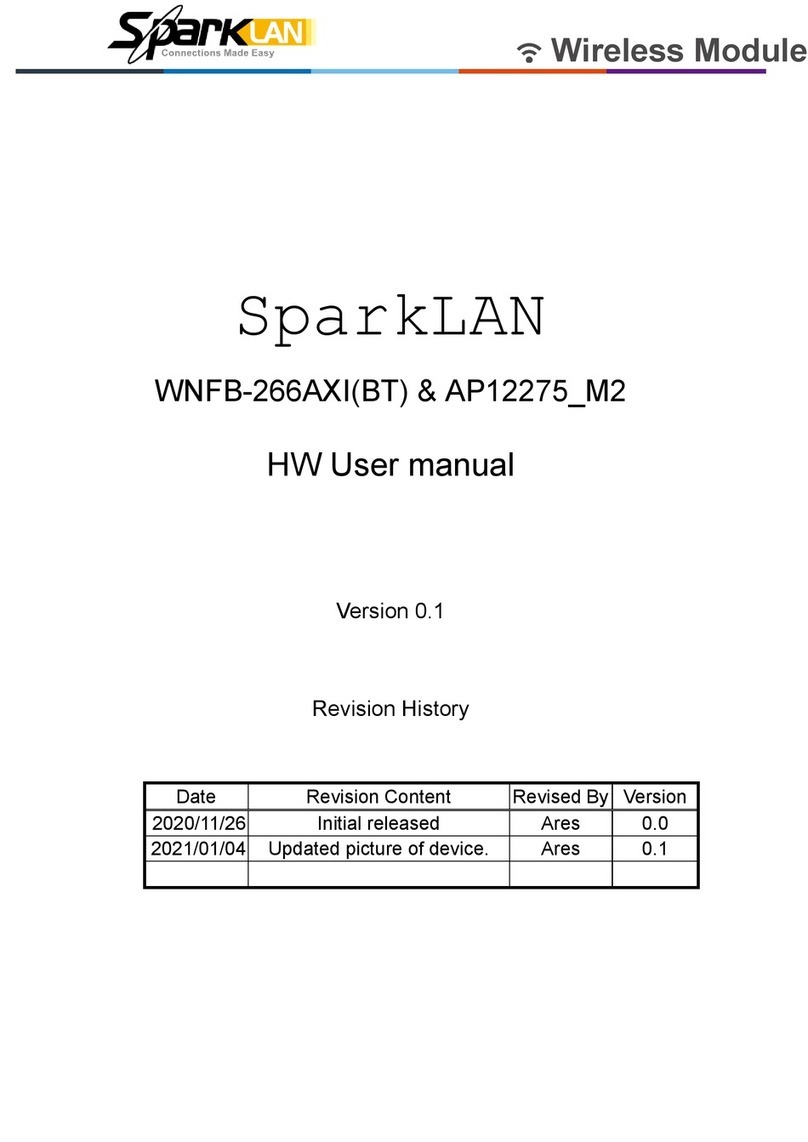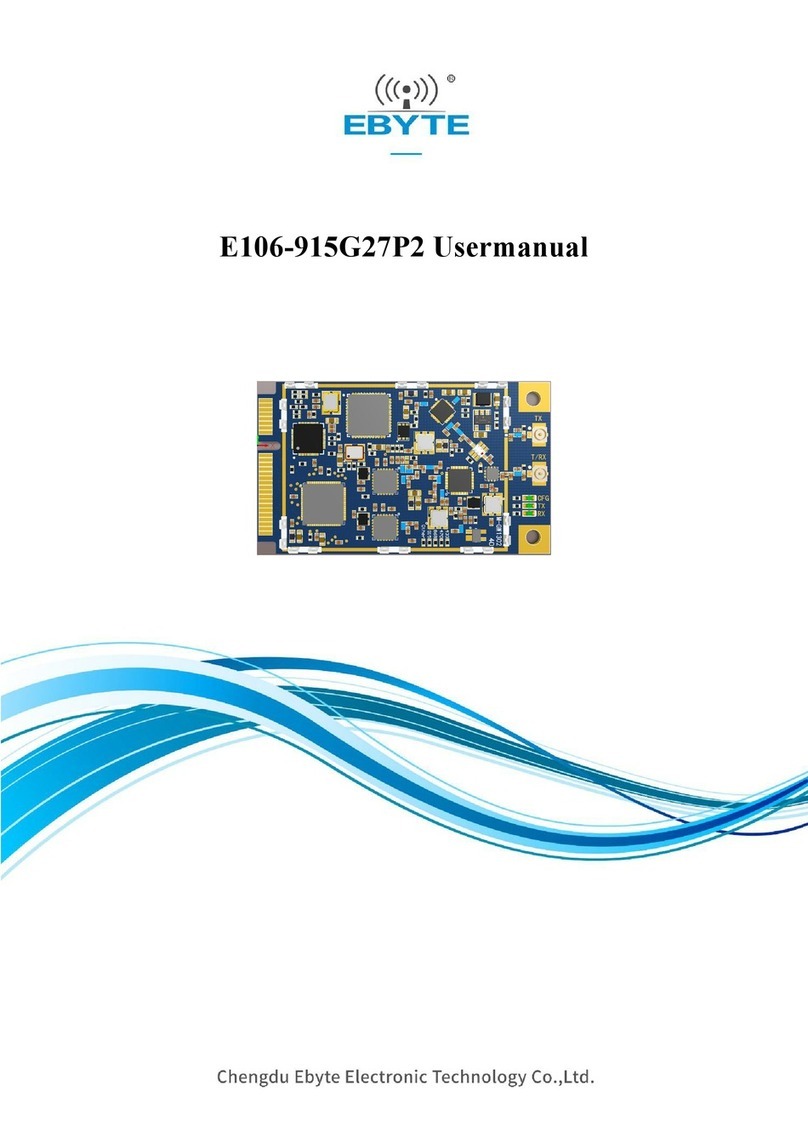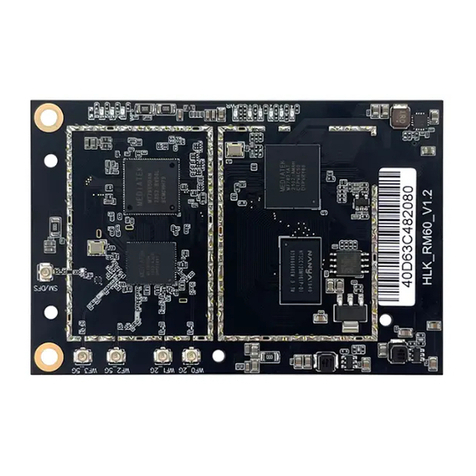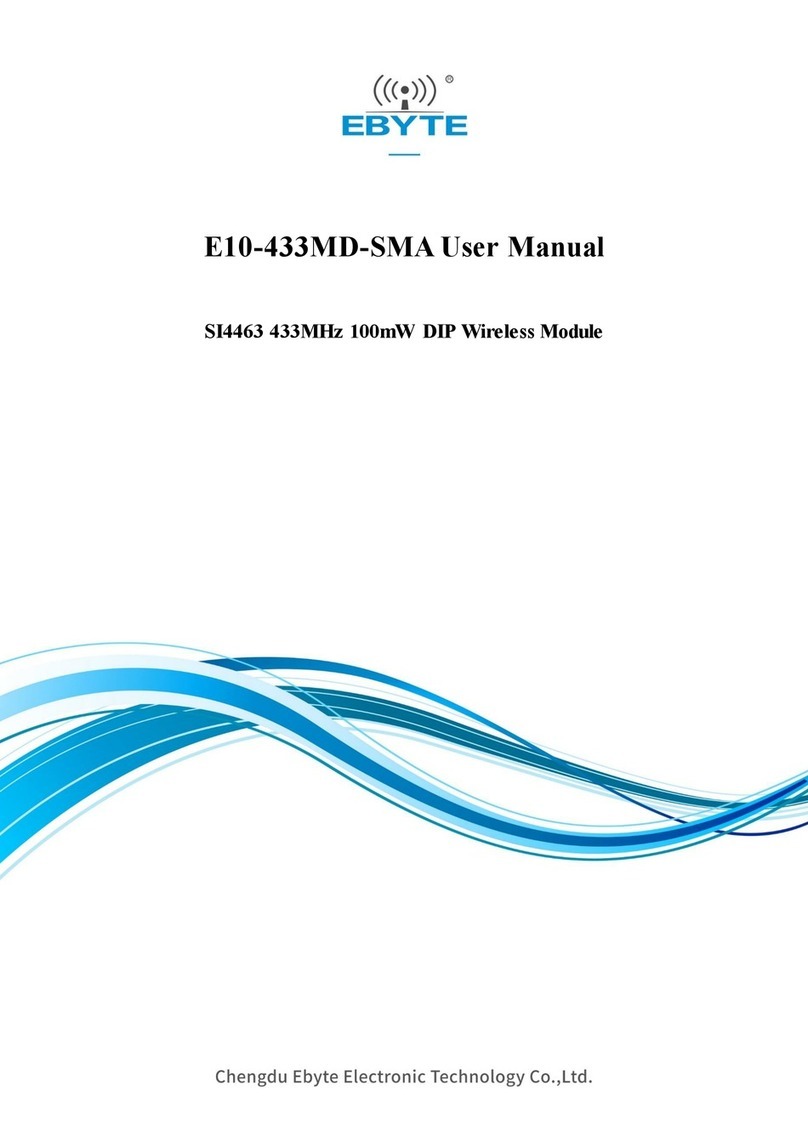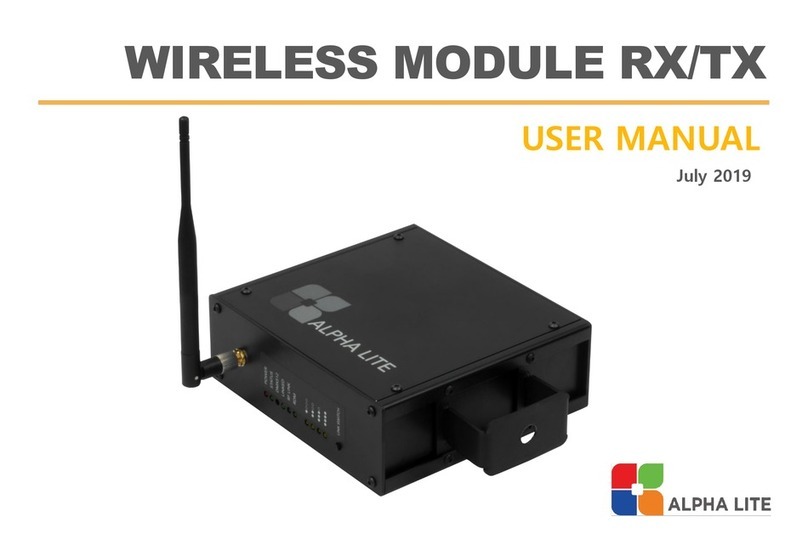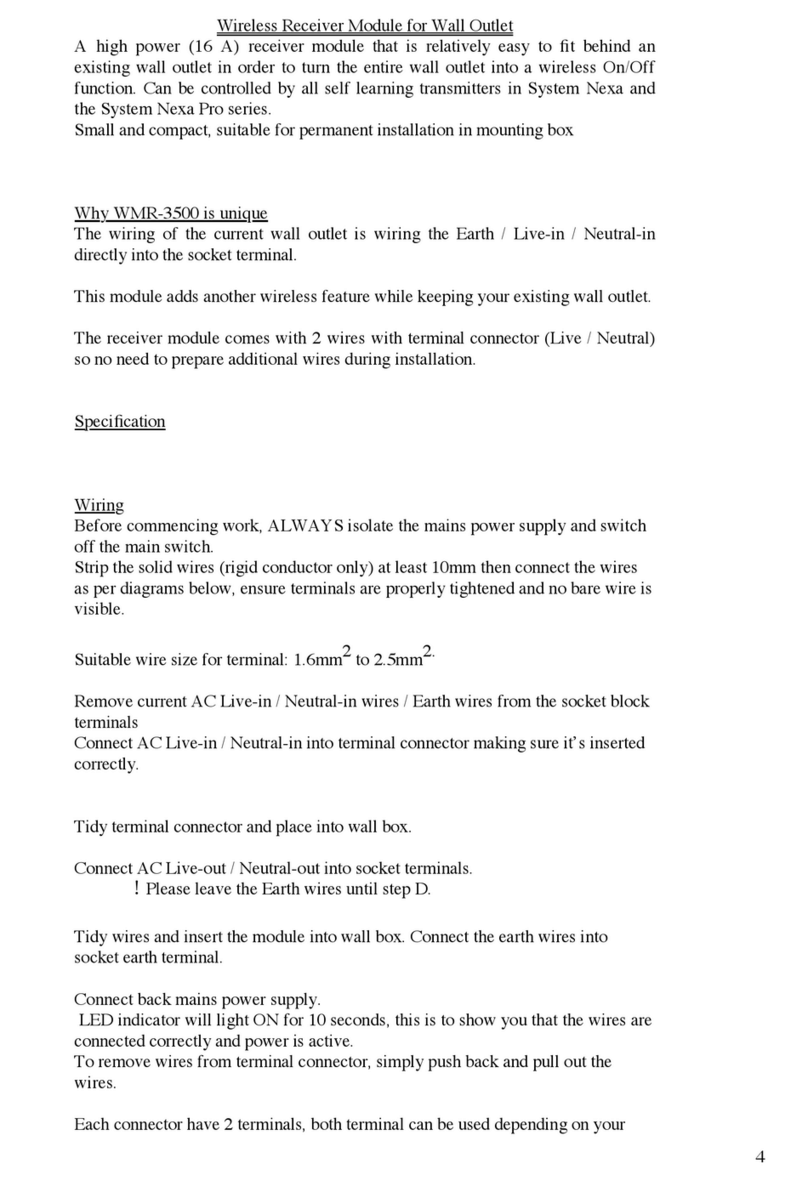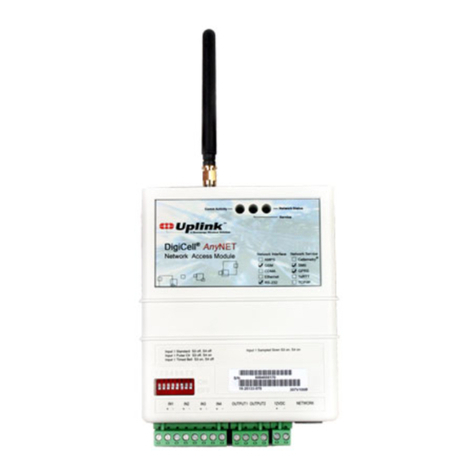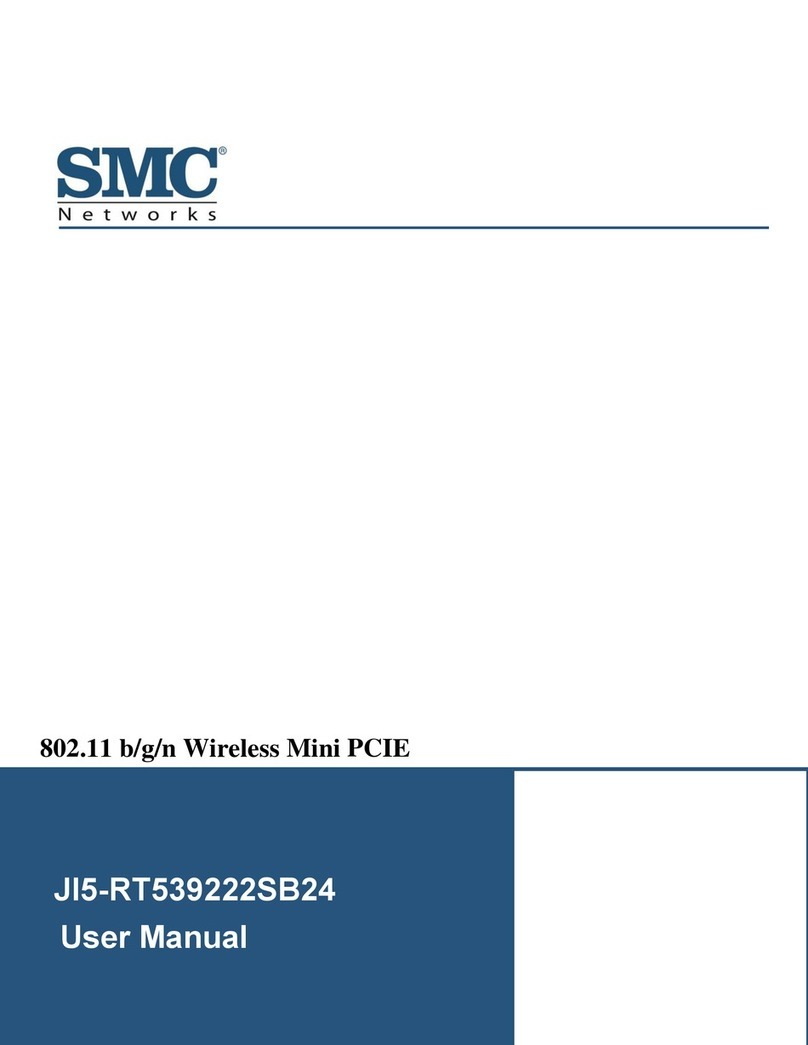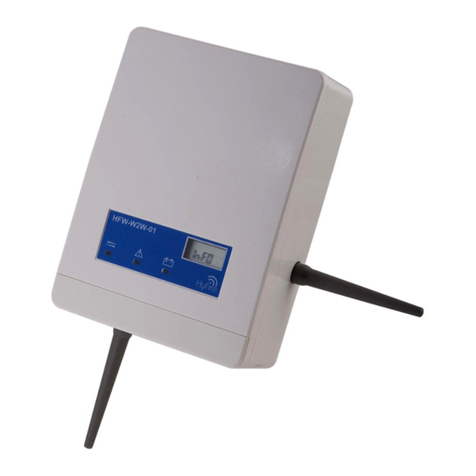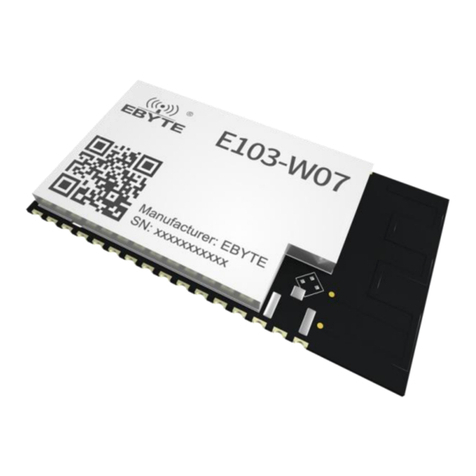Neoway N58 Installation manual

Hardware User Guide
LTE Cat.1 Module
Issue 2.8
Date 2023-03-16

N58 Hardware User Guide
Copyright
Copyright © Neoway Technology Co., Ltd. All rights reserved.
ii
Copyright © Neoway Technology Co., Ltd. 2023. All rights reserved.
No part of thisdocument may bereproduced or transmitted in any form or by any means without prior written
consent of Neoway Technology Co., Ltd.
is the trademark of Neoway Technology Co., Ltd.
All other trademarks and trade names mentioned in this document are the property of their respective
holders.
Notice
This document provides a guide for users to use N58.
This document is intended for system engineers (SEs), development engineers, and test engineers.
THIS GUIDE PROVIDES INSTRUCTIONS FOR CUSTOMERS TO DESIGN THEIR APPLICATIONS.
PLEASE FOLLOW THE RULES AND PARAMETERS IN THIS GUIDE TO DESIGN AND COMMISSION.
NEOWAY WILL NOT TAKE ANY RESPONSIBILITY OF BODILY HURT OR ASSET LOSS CAUSED BY
IMPROPER OPERATIONS.
THE INFORMATION IN THIS DOCUMENT IS SUBJECT TO CHANGE WITHOUT NOTICE DUE TO
PRODUCT VERSION UPDATE OR OTHER REASONS.
EVERY EFFORT HAS BEEN MADE IN PREPARATION OF THIS DOCUMENT TO ENSURE ACCURACY
OF THE CONTENTS, BUT ALL STATEMENTS, INFORMATION, AND RECOMMENDATIONS IN THIS
DOCUMENT DO NOT CONSTITUTE A WARRANTY OF ANY KIND, EXPRESS OR IMPLIED.
Neoway provides customers complete technical support. If you have any question, please contact your
account manager or email to the following email addresses:
Website: http://www.neoway.com

N58 Hardware User Guide
Contents
Copyright © Neoway Technology Co., Ltd. All rights reserved.
iii
Contents
About This Document .................................................................................viii
Scope ...............................................................................................................................................viii
Audience ..........................................................................................................................................viii
Change History.................................................................................................................................viii
Conventions ........................................................................................................................................x
Related Documents............................................................................................................................xi
1 Safety Recommendations .......................................................................12
2 About N58................................................................................................13
2.1 Product Overview....................................................................................................................... 13
2.2 Block Diagram............................................................................................................................ 14
2.3 Basic Features ........................................................................................................................... 15
3 Refference Standards..............................................................................18
4 Pin Definitions..........................................................................................19
4.1 Pad Layout ................................................................................................................................. 19
4.2 Pin Description ........................................................................................................................... 20
5 Application Interfaces ..............................................................................29
5.1 Power Interfaces ........................................................................................................................ 29
5.1.1 VBAT.................................................................................................................................. 29
5.1.2 VDD_1P8........................................................................................................................... 34
5.2 Control Interfaces....................................................................................................................... 34
5.2.1 RESET_N .......................................................................................................................... 34
5.2.2 PWRKEY_N ...................................................................................................................... 36
5.2.3 SLEEP ............................................................................................................................... 39
5.3 Peripheral Interfaces .................................................................................................................. 42
5.3.1 USB ................................................................................................................................... 42
5.3.2 UART................................................................................................................................. 44
5.3.3 USIM.................................................................................................................................. 47
5.3.4 SDIO.................................................................................................................................. 50
5.3.5 SPI..................................................................................................................................... 52
5.3.6 I2C ..................................................................................................................................... 52
5.4 Audio Interfaces ......................................................................................................................... 53
5.4.1 Analog Audio Input Interfaces............................................................................................ 53
5.4.2 Analog Audio Output Interfaces......................................................................................... 54
5.5 Video Interfaces ......................................................................................................................... 57
5.5.1 LCD ................................................................................................................................... 57
5.5.2 Camera.............................................................................................................................. 57
5.6 Other Functional Interfaces........................................................................................................ 58
5.6.1 ADC ................................................................................................................................... 58
5.6.2 NET_LIGHT....................................................................................................................... 58

N58 Hardware User Guide
Contents
Copyright © Neoway Technology Co., Ltd. All rights reserved.
iv
5.6.3 RING.................................................................................................................................. 59
5.6.4 USB_BOOT ....................................................................................................................... 60
5.6.5 VBACKUP and VRTC........................................................................................................ 61
5.6.6 GPIO.................................................................................................................................. 62
5.6.7 GNSS_LNA_EN ................................................................................................................ 62
5.6.8 Keypad .............................................................................................................................. 63
5.6.9 1PPS ................................................................................................................................. 64
5.7 RF Interfaces.............................................................................................................................. 64
5.7.1 ANT_MAIN Antenna Interface ........................................................................................... 64
5.7.2 ANT_GNSS Interface ........................................................................................................ 66
5.7.3 ANT_BT Interface .............................................................................................................. 69
5.7.4 Antenna Assembling.......................................................................................................... 69
6 Electrical Characteristics and Reliability..................................................72
6.1 Electrical Characteristics............................................................................................................ 72
6.2 Temperature Characteristics ...................................................................................................... 73
6.3 ESD Protection Characteristics.................................................................................................. 73
7 RF Characteristics ...................................................................................74
7.1 Operating Frequency Bands ...................................................................................................... 74
7.2 TX Power and RX Sensitivity ..................................................................................................... 75
7.3 GNSS Technical Parameters ..................................................................................................... 76
7.4 WLAN/BT Characteristics .......................................................................................................... 77
8 Mechanical Characteristics......................................................................78
8.1 Dimensions................................................................................................................................. 78
8.2 Labeling...................................................................................................................................... 79
8.3 Packaging................................................................................................................................... 79
8.3.1 Reel ................................................................................................................................... 80
8.3.2 Moisture Sensitivity Level.................................................................................................. 81
9 Mounting N58 onto Application Board .....................................................82
9.1 N58 PCB Package ..................................................................................................................... 82
9.2 Application PCB Package .......................................................................................................... 83
9.3 Stencil......................................................................................................................................... 84
9.4 Solder Paste............................................................................................................................... 84
9.5 Oven Temperature Profile .......................................................................................................... 84
Abbreviations...........................................................................................86

N58 Hardware User Guide
Figures
Copyright © Neoway Technology Co., Ltd. All rights reserved.
v
Figures
Figure 2-1 Block diagram ................................................................................................................. 15
Figure 4-1 Pad layout of N58 (top view) .......................................................................................... 19
Figure 5-1 Voltage drop of the power supply. .................................................................................. 30
Figure 5-2 Recommended power supply design 1 .......................................................................... 30
Figure 5-3 Recommended power supply design 2 .......................................................................... 31
Figure 5-4 Recommended power supply design 3 .......................................................................... 32
Figure 5-5 Recommended power supply design 4 .......................................................................... 33
Figure 5-6 Reference design of push-button reset .......................................................................... 35
Figure 5-7 Reference reset circuit in which a triode is used for isolation......................................... 35
Figure 5-8 Module reset process ..................................................................................................... 36
Figure 5-9 Reference design of push-button startup ....................................................................... 36
Figure 5-10 Reference design of MCU-control startup .................................................................... 37
Figure 5-11 Reference design of automatic startup once powered up ............................................ 37
Figure 5-12 Power-on process......................................................................................................... 38
Figure 5-13 Hardware shutdown process of N58 ............................................................................ 39
Figure 5-14 Process of entering into sleep mode ............................................................................ 40
Figure 5-15 Process of processing data services in sleep mode .................................................... 40
Figure 5-16 Process of waking up the module................................................................................. 41
Figure 5-17 Reference design of module sleep and wake-up control ............................................. 42
Figure 5-18 Recommended design of the USB interface ................................................................ 43
Figure 5-19 Reference design of the UART interface...................................................................... 44
Figure 5-20 Recommended voltage-level translation circuit 1......................................................... 45
Figure 5-21 Recommended voltage-level translation circuit 2......................................................... 46
Figure 5-22 Recommended voltage-level translation circuit 3......................................................... 47
Figure 5-23 Reference design of the USIM interface (normally close connector) ........................... 48
Figure 5-24 Reference design of USIM card interface (normally open connector) ......................... 49
Figure 5-25 Reference design of USIM card interface (without hot-swapping function) ................. 50

N58 Hardware User Guide
Figures
Copyright © Neoway Technology Co., Ltd. All rights reserved.
vi
Figure 5-26 Reference design of the SDIO interface....................................................................... 51
Figure 5-27 Reference design of the SPI interface.......................................................................... 52
Figure 5-28 Reference design of I2C interface................................................................................ 53
Figure 5-29 Reference design of the differential MIC input circuit................................................... 54
Figure 5-30 Reference design of audio interface with internal power amplifier............................... 55
Figure 5-31 Reference design of audio interface with external power amplifier.............................. 56
Figure 5-32 Driving LED indicators with a triode.............................................................................. 59
Figure 5-33 Incoming call RING indication ...................................................................................... 60
Figure 5-34 SMS RING indication.................................................................................................... 60
Figure 5-35 Reference design of USB_BOOT pin ........................................................................... 61
Figure 5-36 Reference design of the VBACKUP and VRTC power supply ..................................... 62
Figure 5-37 Keypad reference design.............................................................................................. 63
Figure 5-38 Schematic diagram of 1PPS output waveform............................................................. 64
Figure 5-39 L-type RF matching schematics ................................................................................... 65
Figure 5-40 T-type RF matching schematics ................................................................................... 65
Figure 5-41 π-type RF matching schematics................................................................................... 65
Figure 5-42 Recommended RF PCB design ................................................................................... 66
Figure 5-43 GNSS RF structure....................................................................................................... 67
Figure 5-44 Reference design of active GNSS antenna.................................................................. 68
Figure 5-45 Reference design of passive GNSS antenna............................................................... 69
Figure 5-46 Murata RF connector encapsulation specifications...................................................... 70
Figure 5-47 RF cable connections ................................................................................................... 70
Figure 5-48 Antenna layout .............................................................................................................. 71
Figure 5-49 Clearance area (No Ground Area) around the antenna on the PCB board ................. 71
Figure 8-1 Top and side view dimensions (unit: mm)....................................................................... 78
Figure 8-2 N58 labels....................................................................................................................... 79
Figure 9-1 Bottom view of N58 PCB package (unit: mm) ................................................................ 82
Figure 9-2 Recommended footprint of the N58 application PCB (unit: mm).................................... 83
Figure 9-3 Oven temperature profile ................................................................................................ 85

N58 Hardware User Guide
Tables
Copyright © Neoway Technology Co., Ltd. All rights reserved.
vii
Tables
Table 2-1 Models and frequency bands ........................................................................................... 13
Table 4-1 IO types and DC characteristics....................................................................................... 20
Table 4-2 Pin description.................................................................................................................. 21
Table 5-1 LCD interface description................................................................................................. 57
Table 5-2 Camera interface description ........................................................................................... 58
Table 6-1 Electrical characteristics................................................................................................... 72
Table 6-2 Current consumption (typical) .......................................................................................... 72
Table 6-3 ESD Protection Characteristics........................................................................................ 73
Table 7-1 Operating frequency bands.............................................................................................. 74
Table 7-2 RF transmit power ............................................................................................................ 75
Table 7-3 RX sensitivity.................................................................................................................... 75
Table 7-4 GNSS technical parameters............................................................................................. 76
Table 7-5 WLAN/ BT TX power and RX sensitivity .......................................................................... 77

N58 Hardware User Guide
About This Document
Copyright © Neoway Technology Co., Ltd. All rights reserved.
viii
About This Document
Scope
This document is applicable to the N58 series. It describes N58 information and functional interface
characteristics, and provides a reference design for each functional interface.
The reference design in this document is for reference only, and user applications must be designed
according to actual scenarios and conditions. If you have any questions, please contact Neoway FAEs.
Audience
This document is intended for system engineers (SEs), development engineers, and test engineers.
Change History
Issue
Date
Change
Author
1.0
2019-11
Initial release.
Zhang Gang
2.0
2020-05
⚫Changed the definitions of pins 13, 78, 80, and 83.
⚫Updated the GNSS characteristics and added the
support for BDS.
⚫Updated the frequency bands of EA and LA variants.
⚫Added the 1PPS pin description of the N58 module
with the GNSS function.
⚫Updated the MIC-related design description.
Zhang Gang
2.1
2020-07
Updated the figure of N58 dimensions and adjusted the
direction of the PCB package figure.
Liu Pengbin
2.2
2020-08
⚫Updated the ADC voltage detection range.
⚫Updated the DC characteristics description P3 and
the 1.8V digital IO voltage type.
⚫Added the description of VBAT Vmin and Vnorm.
⚫Updated the DC characteristics description of
RESET_N and PWRKEY_N pins.
⚫Updated the function of the UART1 interface. This
interface is disabled after the BT function is enabled.
⚫Updated the DC characteristics description of
Walter Wu

N58 Hardware User Guide
About This Document
Copyright © Neoway Technology Co., Ltd. All rights reserved.
ix
USIM1_DET and USIM2_DET pins.
⚫Updated the SDIO reference design.
⚫Updated the resistance value of the pull-up resistor of
the 12C bus.
⚫Deleted the UART level shifting circuit.
⚫Updated the power supply range of VRTC_GPS.
⚫Updated the anode power supply range of LED_K.
⚫Changed the PWRKEY_N startup time to be greater
than 1.8s and less than 3s.
⚫Updated the description and function definitions of
PSM_WAKEUP.
⚫Updated the voltage domain of the LCD and SDIO
interfaces.
2.3
2020-11
⚫Updated the RING pin description and figures.
⚫Updated the UART1 interface description.
⚫Updated the PSM_WAKEUP description and deleted
the DTR description.
Walter Wu
2.4
2021-06
⚫Updated the USB pin name in Figure 4-1 (that is, "HS"
is removed).
⚫Updated the recommended circuit of a USIM card to
explain the handling method of the USIM_DET pin
when a user uses hot plug or does not use hot plug.
⚫Deleted the description of "adaptive" because an SD
card does not support adaptive 1.8 V and 3.0 V
(configured based on the software version).
⚫Updated the dimensions figure and added the "PIN1"
identifier.
⚫Changed the maximum drive current of the RGB LED
to 50 mA.
Wu Yongqiang
2.5
2021-09
⚫Updated the variants, frequency bands, and regions
of N58 modules in Table 2-1.
⚫Updated the block diagram in Figure 2-1.
⚫Updated the description of the application interfaces
in the table of basic features.
⚫Updated the power consumption data in sleep mode,
idle mode, and operating mode.
⚫Added chapter 3 "Refference Standards" to describe
the reference standards of the N58 module design.
⚫Added the VCC_GNSS_BIAS pin description of the
N58 module with the GNSS function.
⚫Updated the N58 module startup, shutdown, and
reset flowcharts.
⚫Added the reference design of the module sleep and
wake-up control circuit.
Wu Yongqiang

N58 Hardware User Guide
About This Document
Copyright © Neoway Technology Co., Ltd. All rights reserved.
x
⚫Added the software (standard/open) version UART
instructions.
⚫Updated the reference design of the UART level
shifting circuit.
⚫Updated the reference design of the USIM interface
circuit.
⚫Added the reference design of the I2C interface
circuit.
⚫Added the 1PPS output waveform diagram.
⚫Updated the description of GNSS technical
parameters.
⚫Added the reference design of the passive GNSS
antenna circuit.
⚫Updated the label diagram.
⚫Updated the table of abbreviations.
⚫Optimized the document to improve its quality.
2.6
2021-11
⚫Added the circuit usage instructions for automatic
startup upon module power-on.
⚫Deleted section 5.6.10 "VCC_GNSS_BIAS."
Wu Yongqiang
2.7
2022-12
⚫Updated schematic design guidelines for the
reference design of the USIM card interface.
⚫Added application PCB design note in Section 9.2 .
⚫Updated information including storage time and
baking time in section 8.3 “Packaging”.
⚫Updated Figure 5-42 "Recommended RF PCB
design”.
⚫Updated the data in Table 4-1
Wu Yongqiang
2.8
2023-02
⚫Modified description for the voltage-level translation
circuit and updated the reference design circuits
Figure 5-20,Figure 5-21, and Figure 5-22 in section
5.3.2 .
⚫Updated the reference design of the USIM interface
in section 5.3.3 “USIM”.
Wu Yongqiang
Conventions
Symbol
Description
Indicates danger or warning. This information must be followed. Otherwise, a
catastrophic module or user device failure or bodily injury may occur.

N58 Hardware User Guide
About This Document
Copyright © Neoway Technology Co., Ltd. All rights reserved.
xi
Indicates caution. This symbol alerts the user to important points about using the
module. If these points are not followed, the module or user device may fail.
Indicates instructions or tips. This symbol provides advices or suggestions that
may be useful when using the module.
Related Documents
Neoway_N58_Datasheet
Neoway_N58_Product_Specifications
Neoway_N58_AT_Commands_Mannual
Neoway_N58_EVK_User_Guide

N58 Hardware User Guide
Chapter 1 Safety Recommendations
Copyright © Neoway Technology Co., Ltd. All rights reserved.
12
1 Safety Recommendations
Please carefully read and strictly abide by the following safety requirements to ensure that the product
application meets the national laws and environmental regulations, avoid risks to personal safety, and
protect the product and application scenario from possible damage:
⚫Do not use the module in places where fire and explosion may occur.
If the module is used in places filled with flammable gases and dust such as propane gas,
gasoline and combustible spray, it will lead to explosion or fire.
⚫In places where wireless communication is prohibited, please disable the wireless
communication function.
In medical facilities or aircraft, the electromagnetic waves emitted by the module may interfere
with the operation of surrounding equipment.
During the product application design and use of this module, the following requirements should be
met:
⚫Do not disassemble the product of this module without permission. Otherwise, after-sales
warranty service will not be available for the product.
⚫Design your application correctly by referring to the HW design guide document and our review
feedback on your PCB design. Connect the product to a stable power supply and lay out traces
following fire safety standards.
⚫Please avoid touching the pins of the module directly in case of damages caused by ESD.
⚫Do not insert or remove (U)SIM card or mobile device memory card if the product is not in
power-off mode.

N58 Hardware User Guide
Chapter 2 About N58
Copyright © Neoway Technology Co., Ltd. All rights reserved.
13
2 About N58
N58 is a 4G industrial-grade module developed based on UNISOC UIS8910DM platform, with external
dimensions of (30.00± 0.10) mm × (28.00± 0.10) mm × (2.50± 0.15) mm. The module provides
connectivity on GSM, FDD-LTE (Cat 1) and TDD-LTE (Cat 1) networks. It provides various hardware
interfaces, supporting audio, video, Wi-Fi positioning, BT/BLE, and GNSS (optional), suitable for
developing IoT communications devices such as wireless meter reading terminal, in-vehicle device,
potable POS device and industrial router.
N58 has the following features:
⚫ARM Cortex-A5 processor, 500 MHz CPU clock speed, 32 KB L1 cache
⚫Supported network modes: GSM/GPRS<E Cat 1
⚫Supports USB2.0/USIM/ADC/UART/SDIO/SPI/I2C/GNSS (optional)
2.1 Product Overview
The N58 series comprises multiple-band modules with four variants suitable for application in various
regions.
Table 2-1 Models and frequency bands
Model
Region
Category
Frequency band
GNSS1
Codec
CA
Chinese mainland
Cat. 1
FDD-LTE: B1, B3, B5, B8
TDD-LTE: B34, B39, B40, B41
GSM/GPRS: 900/1800 MHz
Supported
Supported
EA
Europe/Middle
East/Africa
Cat.1
FDD-LTE: B1, B3, B5, B7, B8,
B20, B28
TDD-LTE: B38, B40, B41
GSM/GPRS: 900/1800 MHz
Supported
Supported
LA
Latin America
Cat.1
FDD-LTE: B1, B2, B3, B4, B5,
B7, B8, B28, B66
TDD-LTE: B38, B40, B41
GSM/GPRS:
850/900/1800/1900 MHz
Supported
Supported
GNSS
1
optional configuration.

N58 Hardware User Guide
Chapter 2 About N58
Copyright © Neoway Technology Co., Ltd. All rights reserved.
14
CA-F1
India
Cat 1
FDD-LTE: B1, B3, B5, B8
TDD-LTE: B40, B41
GSM/GPRS: 900/1800 MHz
Supported
Supported
2.2 Block Diagram
N58 series modules include the following functional units:
⚫Baseband chip
⚫26 MHz crystal
⚫Power management
⚫RF functional
⚫Digital interfaces (USIM, I2C, SPI, KEYPAD, UART, USB, SDIO)
⚫Analog interfaces (ADC, MIC, SPK)

N58 Hardware User Guide
Chapter 2 About N58
Copyright © Neoway Technology Co., Ltd. All rights reserved.
15
Figure 2-1 Block diagram
VBAT
Power
manager
26 MHz
crystal
RF front-end
I2C
Digital interface
USBUART
USIM
PC
ANT_MAIN ANT_BT ANT_GNSS
PWRKEY_N
RESET
KEYP
ADUSIM SPI SDIO
MIC, SPK
GNSS
ADC RF transceiver
Baseband
NOR flash (64 Mb) +
PSRAM (128 Mb)
2.3 Basic Features
Features
Description
Physical features
⚫Dimensions: (30.00 ±0.10) mm ×(28.00 ±0.10) mm ×(2.50 ±0.15)
mm
⚫Package: LGA+LCC
⚫Weight: 4.63 g
Temperature ranges
Operating: -30°C to +75°C
Extended: -40°C to +85°C
Storage: -40°C to +90°C
Operating voltage (DC)
VBAT: 3.4 V to 4.2 V, typical value: 3.8 V

N58 Hardware User Guide
Chapter 2 About N58
Copyright © Neoway Technology Co., Ltd. All rights reserved.
16
Operating current (DC)
Sleep mode2:< 3 mA
Idle mode3:<16 mA
Normal operation mode4(LTE system):< 600 mA
Application processor
ARM Cortex-A5 processor, 500 MHz CPU clock speed, 32 KB L1 cache
Memory
RAM: 128 Mb
ROM: 64 Mb
Frequency band
See Table 2-1.
Wireless rate
GPRS: Max 85.6 kbps (DL)/Max 85.6 kbps (UL)
FDD-LTE: Cat 1, Max 10 Mbps (DL)/Max 5 Mbps (UL)
TDD-LTE: Cat 1, Max 8 Mbps (DL)/Max 2 Mbps (UL)
Transmit power
GSM850: +33 dBm (Power Class 4)
EGSM900: +33 dBm (Power Class 4)
DCS1800: +30 dBm (Power Class 1)
PCS1900: +30 dBm (Power Class 1)
LTE: +23 dBm (Power Class 3)
Application Interfaces
2G/4G antenna, GNSS antenna, BT antenna. The characteristic
impedance of each antenna is 50 Ω.
Three UART interfaces with baud rates up to 921600 bps.
Two USIM interfaces, supporting 1.8 V/3 V USIM cards.
One USB 2.0 interface, for slave mode only.
Three SPI interfaces. One standard SPI interface, for master mode only;
one LCD-dedicated SPI interface; one camera-dedicated SPI interface.
3x4 matrix keyboard interface.
One 12-bit ADC interface, voltage detection range: 0.1 V - VBAT.
One SDIO interface, for SD card.
One 1PPS interface.
One MIC interface with built-in bias voltage range of 2.2 V - 3 V.
One SPK interface, with built-in Class AB/D power amplifier, and output
power up to 800 mW @ 4.2 V / 8 Ω.
Operating currentin sleep mode
2
: means the current drawn by the module in sleep mode, a low power consumption
state, in which its RF function is functioning properly but its peripheral interfaces are disabled. If there is an incoming
call or SMS, the module will exit from the sleep mode, and after the incoming call or voice instant messaging has
ended, the module will re-enter the sleep mode.
Operating currentin idle mode
3
: means the current drawn by the module in a normal operating mode, but no data
service is being processed.
Operating currentin normal operation mode
4
: means the current drawn by the module when there are on-going data
services. In this mode, only the current value in LTE system is exemplified. For other current values in other network
modes, please refer to the current test report.

N58 Hardware User Guide
Chapter 2 About N58
Copyright © Neoway Technology Co., Ltd. All rights reserved.
17
One I2C interface, for master mode only.
AT command
3GPP Release 13
Neoway extended AT commands
SMS
PDU, TXT
Data
PPP, RNDIS, ECM
Protocol
TCP, UDP, MQTT, FTP, HTTP/HTTPS, SSL, TLS
Certification approval
CCC, SRRC, RoHS, CE, CTA

N58 Hardware User Guide
Chapter 3 Refference Standards
Copyright © Shenzhen Neoway Technology Co., Ltd.
18
3 Refference Standards
⚫3GPP TS 36.521-1 V13.0.0 User Equipment (UE) conformance specification; Radio transmission
and reception; Part 1: Conformance Testing
⚫3GPP TS 21.111 V13.0.0 USIM and IC card requirements
⚫3GPP TS 51.011 V4.15.0 Specification of the Subscriber Identity Module -Mobile Equipment
(SIM-ME) interface
⚫3GPP TS 31.102 V13.0.0 Characteristics of the Universal Subscriber Identity Module (USIM)
application
⚫3GPP TS 31.111 V13.0.0 Universal Subscriber Identity Module (USIM) Application Toolkit
(USAT)
⚫3GPP TS 27.007 V13.0.0 AT command set for User Equipment (UE)
⚫3GPP TS 27.005 V13.0.0 Use of Data Terminal Equipment – Data Circuit terminating Equipment
(DTE - DCE) interface for Short Message Service (SMS) and Cell Broadcast Service (CBS)

N58 Hardware User Guide
Chapter 4 Pin Definitions
Copyright © Shenzhen Neoway Technology Co., Ltd.
19
4 Pin Definitions
N58 series modules are equipped with 192 pads, which are introduced in LGA (100 pins) + LCC (92
pins) package. Available functional interfaces include: Power supply, USB, USIM, UART, ADC, I2C,
SDIO, etc.
4.1 Pad Layout
Figure 4-1 shows the pad layout of N58.
Figure 4-1 Pad layout of N58 (top view)
GND
USB_ID
LCC PIN
LGA PIN
GND
GPIO_3
SLEEP
GPIO_2
I2C_SDA
1PPS
UART2_RXD
UART2_TXD
ANT_MAIN
GND 101
96
95
94
93
92
91
90
89
88
87
86
85
84
83
82
81
80
79
78
77
76
75
73
27
72 71 70 69 68 67 66 65 64 63 62 61 60 59 58 57 56 55 54 53 52 51 50
2 3 4 5 6 7 8 9 10 11 12 13 14 15 16 17 18 19 20 21 22 23 24 25
28
29
30
31
32
33
34
35
36
37
38
39
40
41
42
43
44
45
46
47
48
102 103 104 105 106 107 108 109 110 111 112 113 114
156
155
154
153
152
151
150
149
148
147
146
145
144
143
142 141 140 139 138 137 136 135 134 133 132 131 130 129
115
116
117
118
119
120
121
122
123
124
125
126
127
128
SDC_PWR_EN
SDC_DATA2
RING
GND
USIM2_RESET
LCD_SPI_SEL
CAM_SPI_DATA1
GND
GND
GND
GND
I2C_SCL
SPI_MOSI
GPS_LNA_EN
GND
SDC_DET
USB_BOOT
VDD_1P8
USB_VBUS
VBAT
RESERVED
GND
GND
GND
GND
NET_LIGHT
SPI_CLK
SPI_MISO
SPI_CS_N
ADC
ANT_GNSS
GND
ANT_BT
USB_DP
USB_DM
USIM1_DET
USIM1_RESET
USIM1_CLK
USIM1_DATA
USIM1_VCC
RESERVED
PWRKEY_N
RESET_N
GND
GND
VBAT
VBAT
SDC_DATA3
SDC_CMD
SDC_CLK
SDC_DATA0
SDC_DATA1
RESERVED
RESERVED
UART3_RXD
UART3_TXD
GND
SPK_P
SPK_N
MIC_P
MIC_N
GND
USIM2_VCC
USIM2_DATA
USIM2_CLK
USIM2_DET
UART1_RTS
UART1_CTS
UART1_RXD
UART1_TXD
LCD_SPI_SIO
LCD_SPI_SDC
LCD_SPI_CLK
LCD_SPI_CS
LCD_TE
LCD_RST_N
AVDD_CAM
CAM_MCLK
CAM_PWDN
CAM_I2C_SCL
CAM_I2C_SDA
CAM_SPI_CLK
CAM_SPI_DATA0
CAM_RST_N
VDD_CAM
UART2_RTS
UART2_CTS
GPIO_0
VDD_SDCPULL
GND
VBACKUP
RESERVED
GND
RESERVED
RESERVED
RESERVED
GND
RESERVED
RESERVED
LED_K0
VDD_LCD
LED_K1
RESERVED
RESERVED
RESERVED
RESERVED
RESERVED
KEYOUT3
KEYOUT2
KEYOUT1
KEYOUT0
GND
LED_K2
GND
KEYIN3
KEYIN2
KEYIN1
RESERVED
GND
Power
ADC
ControlUSB ReserveUARTLCD
GND
SDIO
Audio
GPIO
Camera
Antenna Keypad SPI I2C Other
USIM
1
172 171 170 169 168 167
173 186 185 184 183 166
174 187 192 191 182 165
175 188 189 190 181 164
176 177 178 179 180 163
157 158 159 160 161 162
GND
GND
GND
GND GND
GND
GND
GND
VRTC
GND
RESERVED
RESERVED
GND
RESERVED
GND
GND
RESERVED
RESERVED
RESERVED
RESERVED
RESERVED
RESERVED
RESERVED
GND
GND
GND
97 98
26
99
49
100
74

N58 Hardware User Guide
Chapter 4 Pin Definitions
Copyright © Shenzhen Neoway Technology Co., Ltd.
20
4.2 Pin Description
The following table lists the IO types and DC characteristics.
Table 4-1 IO types and DC characteristics
IO type
B
Digital input and output, CMOS logic level
DO
Digital output, CMOS logic level
DI
Digital input, CMOS logic level
PO
Power output
PI
Power input
AO
Analog output
AI
Analog input
AIO
Analog input and output
DC characteristics
Interface
type
Power domain
Logic level characteristics
USIM
P1: Both 1.8 V and 3 V SIM types are
supported.
Activation and deactivation with an
automatic voltage switch from 1.8 V to 3
V is implemented
VDD_P1:
1.62 V - 1.98 V (typical value: 1.8 V)
/2.9 V - 3.3 V (typical value: 3 V)
1.8 V DC
characteristics
VIH=0.7VDD_P1 -
VDD_P1
VIL=0V - 0.3VDD_P1
VOH=0.9VDD_P1 -
VDD_P1
VOL=0V - 0.1VDD_P1
3.0 V DC
characteristics
VIH=0.7VDD_P1 -
VDD_P1
VIL=0V - 0.15VDD_P1
VOH=0.9VDD_P1 -
VDD_P1
VOL=0V - 0.1VDD_P1
GPIO
P3: 1.8 V
VDD_P3: 1.7 V - 1.9 V (typical value: 1.8 V)
VIH=0.7VDD_P3 - VDD_P3
VIL=0V - 0.3VDD_P3
VOH=0.8VDD_P3 - VDD_P3
VOL=0V - 0.2VDD_P3
Other manuals for N58
4
Table of contents
Other Neoway Wireless Module manuals
Popular Wireless Module manuals by other brands
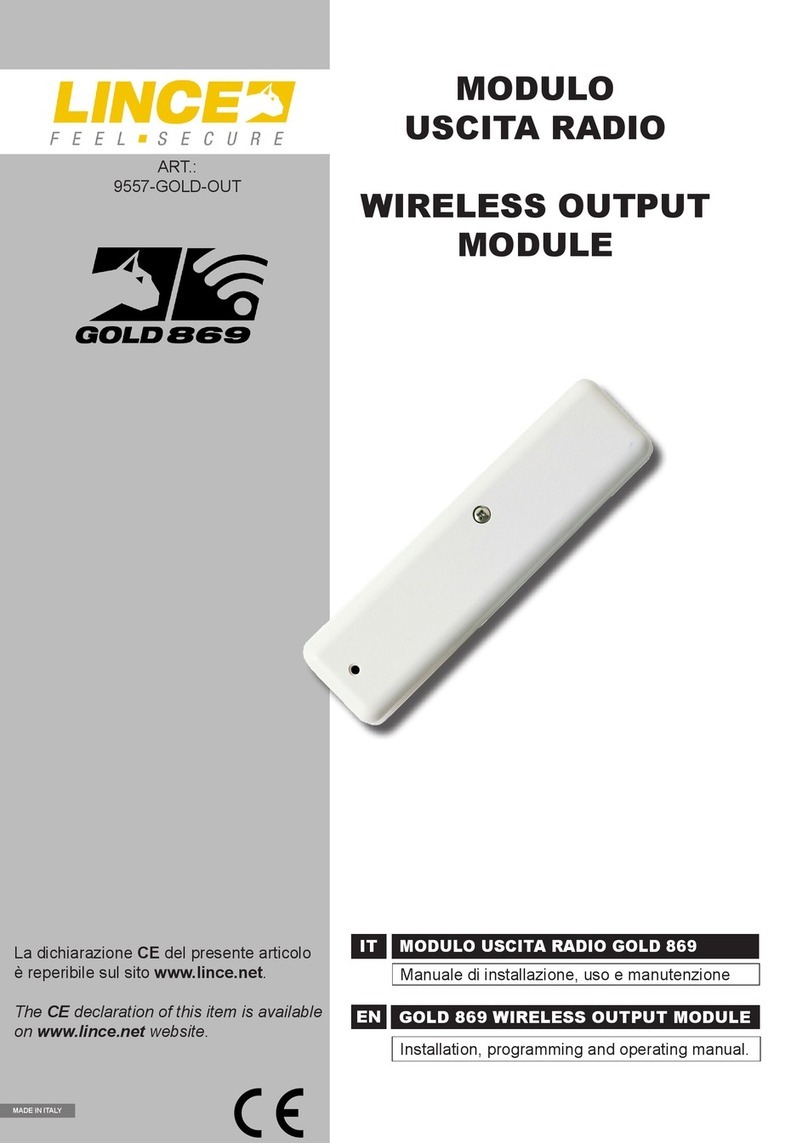
Lince
Lince GOLD 869 9557-GOLD-OUT Installation, Programming and Operating Instructions
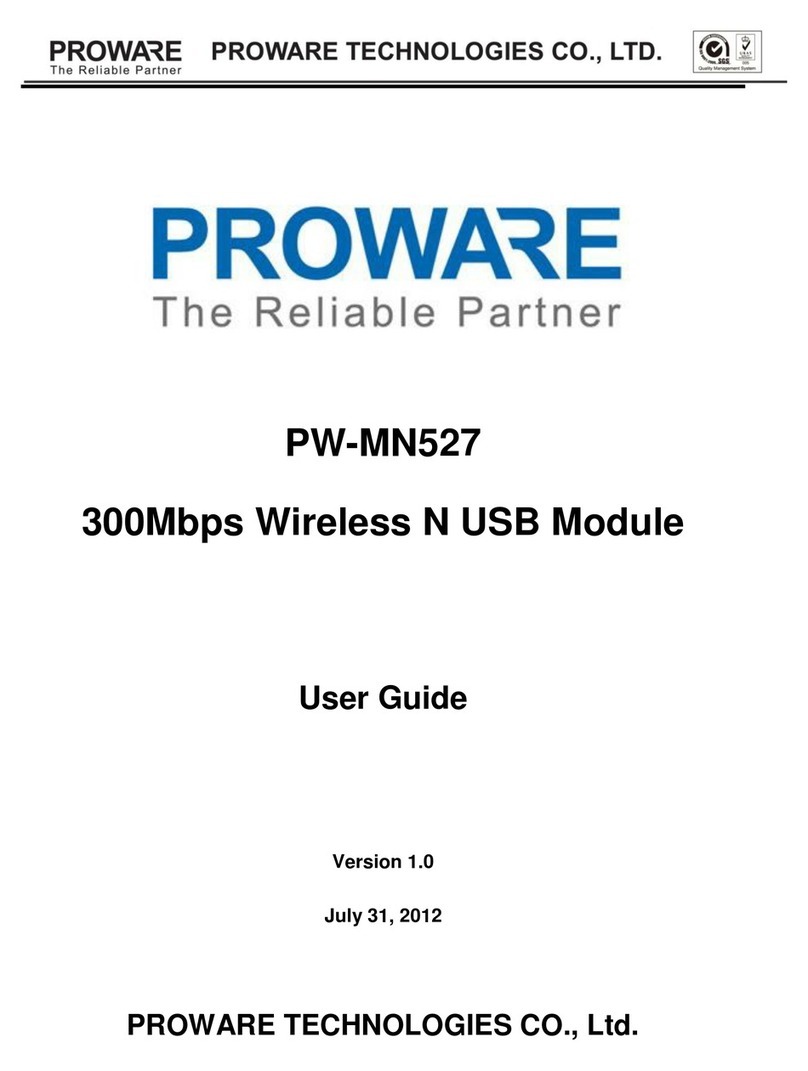
Proware
Proware PW-MN527 user guide
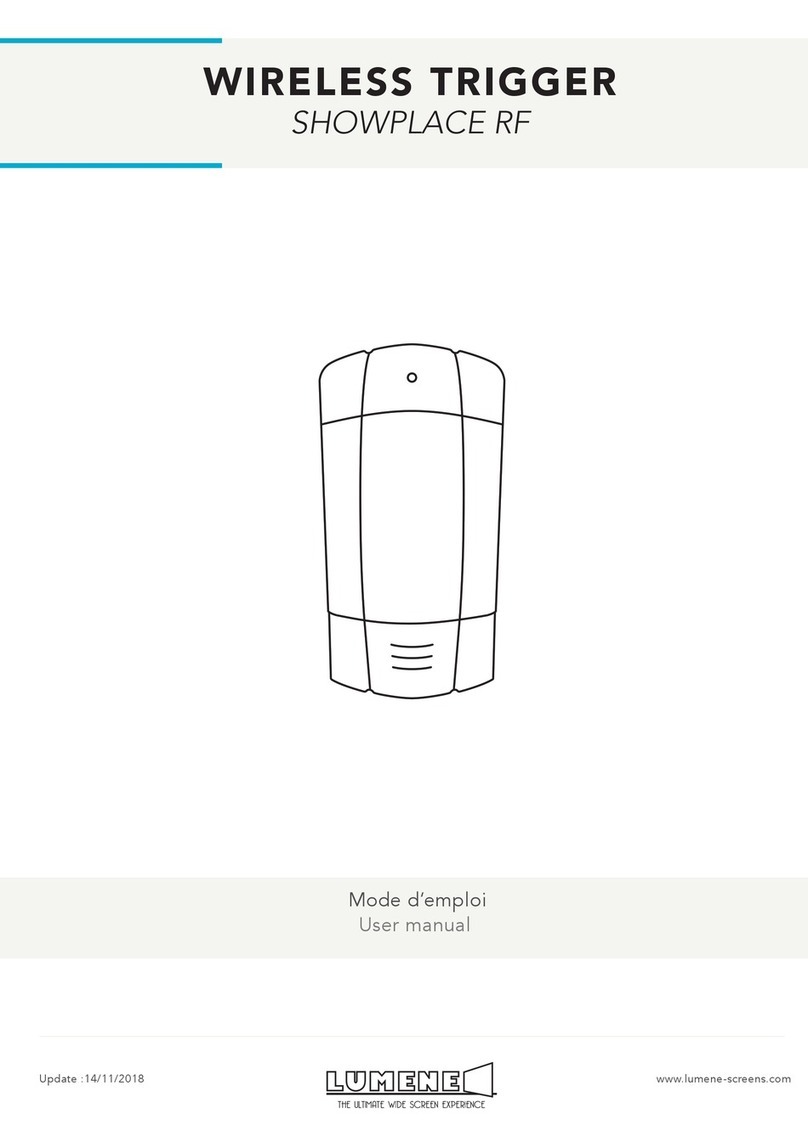
LUMENE
LUMENE SHOWPLACE RF user manual
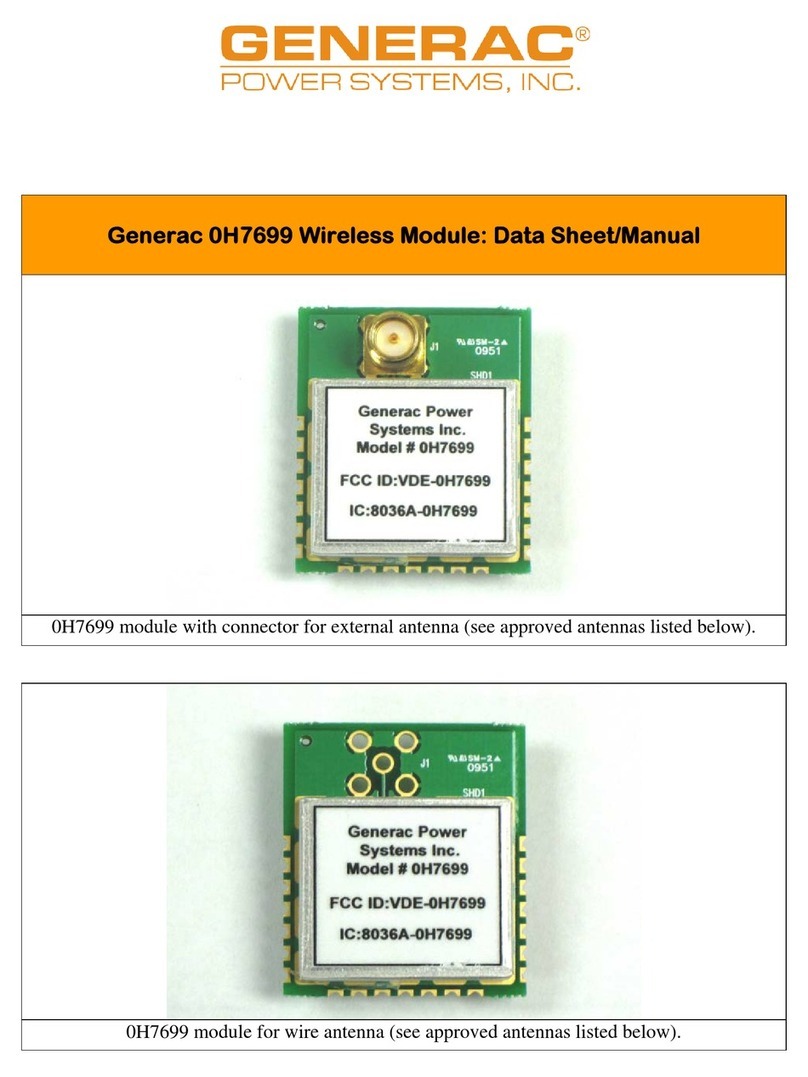
Generac Power Systems
Generac Power Systems 0H7699 Data Sheet / Manual
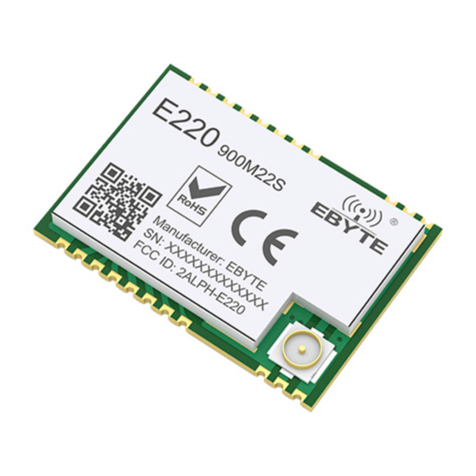
Ebyte
Ebyte E220-900M22S manual
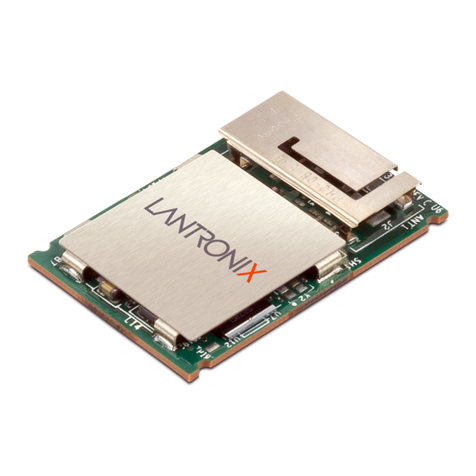
Lantronix
Lantronix xPico 200 Series Certification Firmware Instructions
